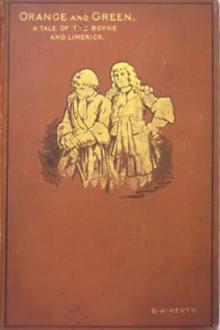Life of St. Francis of Assisi, Paul Sabatier [ebook reader with android os txt] 📗

- Author: Paul Sabatier
Book online «Life of St. Francis of Assisi, Paul Sabatier [ebook reader with android os txt] 📗». Author Paul Sabatier
charissimi (dixit Franciscus),
quodeas perfecte non diligam.... Sed exemplum do vobis, ut
quemadmodum ego facio, ita et vos faciatis. Cf. ibid., 134.
[3] 2 Cel., 3, 55. Fateor veritatem ... nullam me si aspicerem
recogniturum in facie nisi duas . This chapter and the two
following give us a sort of caricature, in which Francis is
represented as so little sure of himself that he casts down his
eyes for fear of yielding to desire. The stories of Francis and
Jacqueline of Settesoli give a very different picture of the
relations between the Brothers and the women in the origin of
the Order from that which was given later. Bernard de Besse
(Turin MS., f^o. 113) relates at length the coming of Jacqueline
to Portiuncula to be present at St. Francis's death. Cf.
Spec. , 107; 133; Bon., 112. Also Clara's repast at
Portiuncula. Fior. , 15; Spec. , 139b.; A. SS. Aug. Vita
Clar. , No. 39 ff.
[4] Isaiah, lxiii., 8 and 9 (Ségond's [French] translation). At
the Mass on Holy Monday Isaiah lxiii. is read for the Epistle
and Mark xiv. for the Gospel.
[5] San Paolo on the Chiasco, near Bastia.
[6] At the present day diocesan seminary of Assisi, " Seminarium
seraphicum ." In the thirteenth century the north gate of the
city was there. The houses which lie between there and the
Basilica form the new town, which is rapidly growing and will
unite the city with Sacro Convento.
[7] Nam steteramus in alio loco, licet parum. Test. Clar. It
is truly strange that there is not a word here for the house
where the first days of her religious life were passed. Cf.
Vit. , no. 10: S. Angelus de Panse ... ubi cum non plene mens
ejus quiesceret.
[8] Mittarelli, Annales Camaldulenses (Venice, 1755-1773, 9
vols., f^o.), t. iv., app. 431 and 435. Cf. 156.
[9] The act of donation is still in the archives of Assisi. An
analysis of it will be found in Cristofani, t. i., p. 133. Their
munificence remained without result; the bull Ab Ecclesia of
July 27, 1232, shows that they were suppressed less than twenty
years after. Sbaralea , t. 1, p. 81. Potthast, 8984. Cf., ib.,
p. 195, note c, and 340, note a, and the bulls which are there
indicated.
[10] See p. 81, note ii.
[11] 1 Cel., 18; 21; 3 Soc., 24; 2 Cel., 1, 8.
[12] An. Perus. , A. SS., p. 600. Cf. 3 Soc., 60. The three
Orders are contemporary, one might even say, the four, including
among them the one that miscarried among the secular priests
(see below).
In a letter St. Clara speaks of her Order as making only a part
with that of the Brothers: Sequaris consilia Reverendi Patris
nostri fratris Eliæ Ministri generalis totius ordinis . A. SS.,
Martii, t. i., p. 507.
[13] This point of view is brought into relief by an anecdote in
the De laudibus of Bernard of Besse (Turin MS., 113a). This is
how he ends chap. vii. on the three Orders: Nec Santus his
contentus ordinibus satagebat omnium generi salutis et
penitentiæ viam dare. Unde parochiali cuidam sacerdoti dicenti
sibi quod vellet suus, retenta tamen ecclesia. Frater esse, dato
vivendi et induendi modo, dicitur indixisse ut annuatim,
collectis Eclesiæ fructibus daret pro Deo, quod de præteritis
superesset.
[14] See the lovely story in the Fior. , 13. Cf. Spec. , 65a;
Conform. , 168b. 1.
[15] The text of it was doubtless formerly inserted in chapter
vi. of the Rule granted to the Clarisses of St. Damian, August
9, 1253, by the bull Solet annuere . Potthast, 15,086. But this
chapter has been completely changed in many editions. The text
of the Speculum , Morin, Rouen 1509, should be read. Tract
iii., 226b. The critical study to be made upon this text by
comparing the indications given by the bull Angelis guadium of
May 11, 1238, Sbaralea, i., p. 242, is too long to find a place
here.
[16] 2 Cel., 3, 132. Cf. Test. B. Clar.
[17] In illa gravi infirmitate ... faciebat se erigi ... et
sedens filabat. A. SS., 760e. Sic vult eas [sorores] operare
manibus suis. Ib. 762a.
[18] Fior. 33.
[19] Rule of 1221, chap xii. Et nulla penitus mulier ab aliquo
frater recipiatur ad obedientiam, sed dato sibi consilio
spirituali, ubi voluerit agat penitentiam. Cf. below, p. 252,
note 1, the remainder of this chapter and the indication of the
sources. This proves, 1, that the friars had received women into
the Order; 2, that at the beginning they said The Order in the
singular, and under this appellation included Sisters as well as
Brothers. We see how far the situation was, even at the end of
1221, from being what it became a few years later. It is to be
noted that in all the reforming sects of the commencement of the
thirteenth century the two sexes were closely united. (Vide
Burchardi chronicon , Pertz, 1, 23, p. 376. Cf. Potthast, 2611,
bull Cum otim of Nov. 25, 1205.)
On the 7th of June, 1201 (bull Incunubit nobis ), Innocent III.
had approved the Rule of the Humiliants. This was a religious
association whose members continued to live in their own homes,
and who offer surprising points of contact with the Franciscan
Order, though they took no vow of poverty. From them issued a
more restricted association which founded convents where they
worked in wool; these convents received both men and women. Vide
Jacques de Vitry, Hist. Occidentalis , cap. 28. De religione
et regula Humiliatorum (Douai, 1597, pp. 334-337). The time
came when from these two Orders issued a third, composed solely
of priests. These Humiliati are too little known, though they
have had a historian whose book is one of the noble works of the
eighteenth century: Tiraboschi, Vetera Humiliatorum monumenta
(Milan, 3 vols., 4to, 1766-1768). Toward 1200 they had
monopolized l'arte della lana in all upper Italy as far as to
Florence; it is evident, therefore, that Francis's father must
have had relations with them.
[20] The bull approving the Rule of St. Damian is of August 9,
1253. Clara died two days later.
[21] 1 Cel., 122. Cf. Potthast, 8194 ff.; cf. ib., 709.
[22] A. SS., Vita Cl. , p. 758. Cf. bull of canonization.
[23] Vit. S. Clar. , A. SS., p. 758. This petition was surely
made by the medium of Francis; and there are several indications
of his presence in Perugia in the latter part of the life of
Innocent III. In obitu suo [Alexandri papæ] omnes familiares
sui deseruerunt eum præter fratres Minores. Et similiter Papam
Gregorium et Honorium et Innocentium in cujus obitu fuit
præsentialiter S. Franciscus. Eccl. xv. Mon. Germ. hist.
Script. , t. 28 p. 568. Sbaralea puts forth doubts as to the
authenticity of this privilege, the text of which he gives;
wrongly, I think, for Clara alludes to it in her will, A. SS.,
p. 747.
[24] He was born about 1147, created cardinal in 1198. Vide
Raynald, ann. , 1217, §
quodeas perfecte non diligam.... Sed exemplum do vobis, ut
quemadmodum ego facio, ita et vos faciatis. Cf. ibid., 134.
[3] 2 Cel., 3, 55. Fateor veritatem ... nullam me si aspicerem
recogniturum in facie nisi duas . This chapter and the two
following give us a sort of caricature, in which Francis is
represented as so little sure of himself that he casts down his
eyes for fear of yielding to desire. The stories of Francis and
Jacqueline of Settesoli give a very different picture of the
relations between the Brothers and the women in the origin of
the Order from that which was given later. Bernard de Besse
(Turin MS., f^o. 113) relates at length the coming of Jacqueline
to Portiuncula to be present at St. Francis's death. Cf.
Spec. , 107; 133; Bon., 112. Also Clara's repast at
Portiuncula. Fior. , 15; Spec. , 139b.; A. SS. Aug. Vita
Clar. , No. 39 ff.
[4] Isaiah, lxiii., 8 and 9 (Ségond's [French] translation). At
the Mass on Holy Monday Isaiah lxiii. is read for the Epistle
and Mark xiv. for the Gospel.
[5] San Paolo on the Chiasco, near Bastia.
[6] At the present day diocesan seminary of Assisi, " Seminarium
seraphicum ." In the thirteenth century the north gate of the
city was there. The houses which lie between there and the
Basilica form the new town, which is rapidly growing and will
unite the city with Sacro Convento.
[7] Nam steteramus in alio loco, licet parum. Test. Clar. It
is truly strange that there is not a word here for the house
where the first days of her religious life were passed. Cf.
Vit. , no. 10: S. Angelus de Panse ... ubi cum non plene mens
ejus quiesceret.
[8] Mittarelli, Annales Camaldulenses (Venice, 1755-1773, 9
vols., f^o.), t. iv., app. 431 and 435. Cf. 156.
[9] The act of donation is still in the archives of Assisi. An
analysis of it will be found in Cristofani, t. i., p. 133. Their
munificence remained without result; the bull Ab Ecclesia of
July 27, 1232, shows that they were suppressed less than twenty
years after. Sbaralea , t. 1, p. 81. Potthast, 8984. Cf., ib.,
p. 195, note c, and 340, note a, and the bulls which are there
indicated.
[10] See p. 81, note ii.
[11] 1 Cel., 18; 21; 3 Soc., 24; 2 Cel., 1, 8.
[12] An. Perus. , A. SS., p. 600. Cf. 3 Soc., 60. The three
Orders are contemporary, one might even say, the four, including
among them the one that miscarried among the secular priests
(see below).
In a letter St. Clara speaks of her Order as making only a part
with that of the Brothers: Sequaris consilia Reverendi Patris
nostri fratris Eliæ Ministri generalis totius ordinis . A. SS.,
Martii, t. i., p. 507.
[13] This point of view is brought into relief by an anecdote in
the De laudibus of Bernard of Besse (Turin MS., 113a). This is
how he ends chap. vii. on the three Orders: Nec Santus his
contentus ordinibus satagebat omnium generi salutis et
penitentiæ viam dare. Unde parochiali cuidam sacerdoti dicenti
sibi quod vellet suus, retenta tamen ecclesia. Frater esse, dato
vivendi et induendi modo, dicitur indixisse ut annuatim,
collectis Eclesiæ fructibus daret pro Deo, quod de præteritis
superesset.
[14] See the lovely story in the Fior. , 13. Cf. Spec. , 65a;
Conform. , 168b. 1.
[15] The text of it was doubtless formerly inserted in chapter
vi. of the Rule granted to the Clarisses of St. Damian, August
9, 1253, by the bull Solet annuere . Potthast, 15,086. But this
chapter has been completely changed in many editions. The text
of the Speculum , Morin, Rouen 1509, should be read. Tract
iii., 226b. The critical study to be made upon this text by
comparing the indications given by the bull Angelis guadium of
May 11, 1238, Sbaralea, i., p. 242, is too long to find a place
here.
[16] 2 Cel., 3, 132. Cf. Test. B. Clar.
[17] In illa gravi infirmitate ... faciebat se erigi ... et
sedens filabat. A. SS., 760e. Sic vult eas [sorores] operare
manibus suis. Ib. 762a.
[18] Fior. 33.
[19] Rule of 1221, chap xii. Et nulla penitus mulier ab aliquo
frater recipiatur ad obedientiam, sed dato sibi consilio
spirituali, ubi voluerit agat penitentiam. Cf. below, p. 252,
note 1, the remainder of this chapter and the indication of the
sources. This proves, 1, that the friars had received women into
the Order; 2, that at the beginning they said The Order in the
singular, and under this appellation included Sisters as well as
Brothers. We see how far the situation was, even at the end of
1221, from being what it became a few years later. It is to be
noted that in all the reforming sects of the commencement of the
thirteenth century the two sexes were closely united. (Vide
Burchardi chronicon , Pertz, 1, 23, p. 376. Cf. Potthast, 2611,
bull Cum otim of Nov. 25, 1205.)
On the 7th of June, 1201 (bull Incunubit nobis ), Innocent III.
had approved the Rule of the Humiliants. This was a religious
association whose members continued to live in their own homes,
and who offer surprising points of contact with the Franciscan
Order, though they took no vow of poverty. From them issued a
more restricted association which founded convents where they
worked in wool; these convents received both men and women. Vide
Jacques de Vitry, Hist. Occidentalis , cap. 28. De religione
et regula Humiliatorum (Douai, 1597, pp. 334-337). The time
came when from these two Orders issued a third, composed solely
of priests. These Humiliati are too little known, though they
have had a historian whose book is one of the noble works of the
eighteenth century: Tiraboschi, Vetera Humiliatorum monumenta
(Milan, 3 vols., 4to, 1766-1768). Toward 1200 they had
monopolized l'arte della lana in all upper Italy as far as to
Florence; it is evident, therefore, that Francis's father must
have had relations with them.
[20] The bull approving the Rule of St. Damian is of August 9,
1253. Clara died two days later.
[21] 1 Cel., 122. Cf. Potthast, 8194 ff.; cf. ib., 709.
[22] A. SS., Vita Cl. , p. 758. Cf. bull of canonization.
[23] Vit. S. Clar. , A. SS., p. 758. This petition was surely
made by the medium of Francis; and there are several indications
of his presence in Perugia in the latter part of the life of
Innocent III. In obitu suo [Alexandri papæ] omnes familiares
sui deseruerunt eum præter fratres Minores. Et similiter Papam
Gregorium et Honorium et Innocentium in cujus obitu fuit
præsentialiter S. Franciscus. Eccl. xv. Mon. Germ. hist.
Script. , t. 28 p. 568. Sbaralea puts forth doubts as to the
authenticity of this privilege, the text of which he gives;
wrongly, I think, for Clara alludes to it in her will, A. SS.,
p. 747.
[24] He was born about 1147, created cardinal in 1198. Vide
Raynald, ann. , 1217, §
Free e-book «Life of St. Francis of Assisi, Paul Sabatier [ebook reader with android os txt] 📗» - read online now
Similar e-books:





Comments (0)